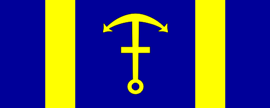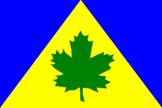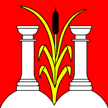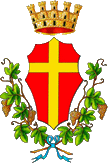Dictionary of Vexillology: I (Invected – Italian Shield) (original) (raw)
INVECTED (INVECKED or INVECQUED)
(adj) The alternative heraldic terms used when a division in the field of a banner of arms or shield, or the edge of an ordinary, is cut into a series of projecting curves or half circles strung together – that is with the half-circles facing outward and the points inward – invecked, envecked, or invecqued – see engrailed (also armorial bearings, banner of arms, coat of arms, ordinary,shield, and scalloped).



Flag of Oberhof, Switzerland; Flag of Vestre Slidre, Norway; Flag of Massagno, Switzerland
INVERTED
On flags a term which may be used when a charge or charges, that are (or that may be) orientated vertically, are shown as being turned upside down (see also ‘chevron’, ‘pall’ and ‘pile’).
In heraldry see ‘reversed 2)’.

Flag of Cirkulane, Slovenia
INVERTED CHEVRON
See ‘chevron 1)’ and ‘chevron 2)’.

Flag of Birżebbuġa, Malta
INVERTED PALL
See ‘pall 1)’.

Flag of Kråkerøy, Norway
INVERTED PILE
See ‘pile 1)’.

Flag of Šárovcova Lhota, Czechia
INVERTED TRIANGLE
See ‘triangle 2)’.
[ ![[Gay triangle flag]](http://www.crwflags.com/fotw/images/v/vxt-d009.gif) ](../images/v/vxt-d009.gif)
](../images/v/vxt-d009.gif)
A Gay Triangle Flag
IRISH SALTIRE
See ‘St. Patrick's Cross’ and its following note.
[ ![[St. Patrick's Cross]](http://www.crwflags.com/fotw/images/v/vxt-d397.gif) ](../images/v/vxt-d397.gif)
](../images/v/vxt-d397.gif)
IRON CROSS
The term (derived from an originally Prussian later German military decoration) that describes a distinctly Germanic form of the cross pattee – see ‘cross pattée’ and ‘Teutonic cross’ (also ‘balkenkreuz’ and ‘Hanseatic cross’).
[ ![[German Naval Jack]](http://www.crwflags.com/fotw/images/v/vxt-d593.gif) ](../images/v/vxt-d593.gif) [
](../images/v/vxt-d593.gif) [ ![[Iron Cross]](http://www.crwflags.com/fotw/images/v/vxt-d4209.gif) ](../images/v/vxt-d4209.gif) [
](../images/v/vxt-d4209.gif) [ ![[iron cross]](http://www.crwflags.com/fotw/images/v/vxt-d4567.gif) ](../images/v/vxt-d4567.gif)
](../images/v/vxt-d4567.gif)
Naval Jack 1903–1919, Germany; Iron Cross 1813, Prussia (Wikipedia); Flag of the Defense Minister 1933–1935, Germany
Notes a) The above term should only be used when the cross pattée being described is black, carries a white or silver border and/or is of Germanic origin. b) Although based upon a military decoration this cross was ultimately derived from the symbol of the Medieval Teutonic Order as referenced above.
ISSUANT (or ISSANT)
The alternative heraldic terms used when a charge emerges out of the base of a field or a chief, from an ordinary or from the upper edge of a fess, or from a coronet – issant or rising from –, but see the important note below and ‘naissant 1)’ (also ‘charge 1)’, ‘chief’, ‘coronet 1)’ and ‘fess’).



Flag of Sâles, Switzerland; Flag of Recknitz-Trebeltal, Germany; Flag of Augst, Switzerland
Please note that in modern heraldry the term for a charge or figure emerging from the side of a shield, banner of arms or a flag is naissant – see ‘naissant 1)’.
ITALIAN PROVINCIAL CROWN
See ‘provincial crown 1)’.

Flag of Alessandria, Italy
ITALIAN SHIELD
The term sometimes used to describe a shield of the decorative, post-medieval type most often seen in Italian personal and civic heraldry but see note below – a horse-head shield (also Renaissance Shield).

The Arms of Messina, Italy (ita24)
Please note that several of the terms giving shields a national identity, as well as those describing a specific type, are still in the process of standardization, and that no consistent approach has thus far been identified.